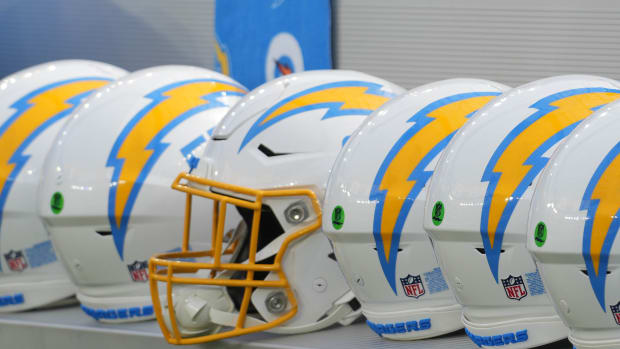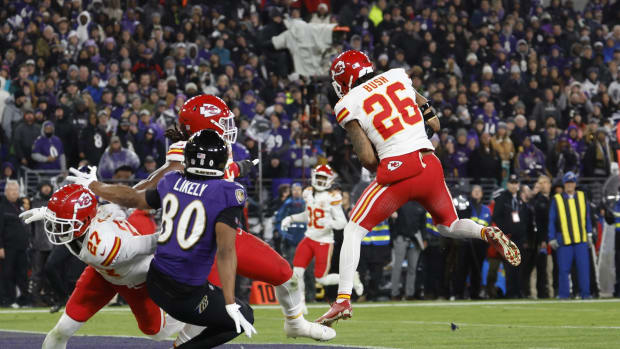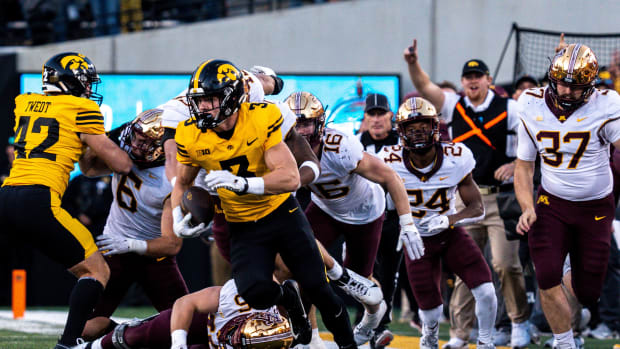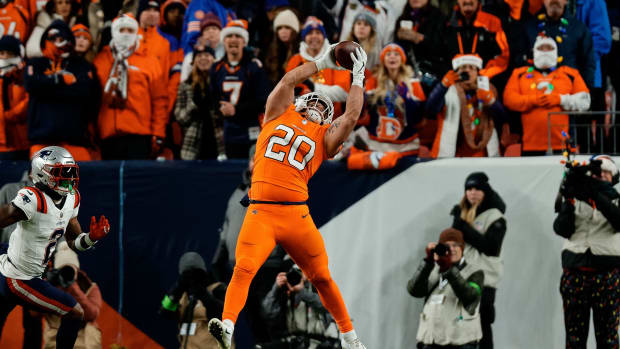Outrage over new helmet rule much ado about nothing
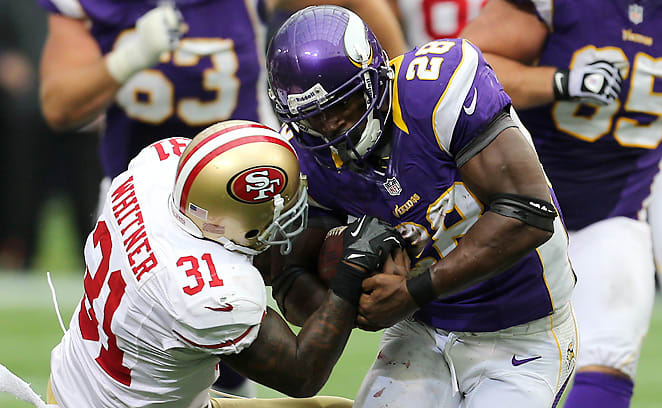
For a back like Adrian Peterson, who embraces contact, the new helmet rule could be confusing.
Rich Gabrielson/Icon SMI
PHOENIX -- Emmitt Smith, Matt Forte, Eric Dickerson and running backs everywhere may squawk, but every change the NFL makes these days on behalf of player safety makes somebody squawk, doesn't it? Should the league really care? Not if it feels like it's on solid ground, as it does with the common-sense proposal that would ban players from using the crown of their helmet in the open field.
The reality is this: The rule change, passed at this week's NFL annual meeting at the Arizona Biltmore, won't represent a sea change in the way running backs ply their craft. Education and adaptation will help mitigate this issue in time. But we're not there yet. We're really only in the beginning stages of the debate, and that means the loud crowd often drowns out all else, with Smith saying anyone proposing such a rule has "absolutely lost (their) mind,'' and Forte claiming that it "might be the most absurd suggestion for a rule change that I've ever heard.''
Provocative, inflammatory quotes to be sure, but here's a heads-up, guys: The league's effort to legislate against heads-down contact isn't going away any time soon. With brain injuries and concussions still being the hot-button topic in the league, this train is moving in only one direction. And it's not back to the day when a Walter Payton or an Earl Campbell gave us all those iconic images of them dropping their head and burying it in the chest of an over-matched linebacker or defensive back in the pursuit of five extra yards.
"I'm in favor of it and I think it's a good rule that we need,'' said Super Bowl-winning Baltimore head coach John Harbaugh, of the league's decision to penalize the crown-of-the-helmet hit in the open field. "When you look at all the plays involved, what becomes apparent is what they're talking about calling is a dangerous position for any player to be. You never teach a running back to lead with the crown of the helmet and you never teach a tackler to lead with the crown of the helmet. No one's taught that from the beginning of football.
"We teach them just the opposite, to see what you hit, or if you go low, to use your shoulder. A back can still go low with his head, he just can't square up on a guy and lead with the crown of his helmet. That's something that's putting people in jeopardy. So I came out of the meetings feeling good about the rule.''
Apparently so did league owners, because the proposal passed easily Wednesday morning, with a reported 31-1 vote (only Cincinnati opposed), far more than the needed 24 yeahs.
Club and league sources I talked to this week do not view the rule as leaving running backs in a defenseless position, as Smith, the NFL's all-time leading rusher, maintains. Backs can still go low to protect themselves, but they can't spear a defender with their helmets outside the so-called "tackle box,'' any more than a defender can spear them.
Sorry, Emmitt, but in this era of greater awareness of head trauma, this one is a no-brainer, so to speak.
"This really just tends to be about the broader view of society's view of change, and the reality that we have difficulty changing long-held habits,'' said Willie Lanier, the Hall of Fame Kansas City Chiefs middle linebacker and member of the NFL's Player Safety Advisory Committee. "And for Emmitt, or whoever has questions about the rule, sometimes their comments are based on the self-interest of the individual speaking at the time. People get trapped in the way things have been before. They get trapped in the warrior mentality. But sometimes it takes people willing to take another look and making change. You have to be open to make change.''
Lanier has been willing to make changes ever since suffering an undiagnosed subdural hematoma in the first game of his rookie season of 1967 with the Chiefs. He dove to make a tackle in that game, and took a knee to the head. He felt woozy but didn't leave that game or report his concussion. But the following week, he went to call the defensive signals in the huddle in the first quarter, and collapsed, remaining unconscious for two hours. Lanier eventually went to the Mayo Clinic looking for answers to his condition. He missed four games, but when he returned, he came back determined to play the game as safely as possible, never dropping his head in order to tackle, and wrapping up ballcarriers with his body.
"The reality is because I made a good decision back then, I'm able to talk to you today,'' said Lanier, reached by phone. "If I don't make that decision, maybe we're not having this discussion. Obviously my decision led to an outstanding career. It didn't diminish anything. I played with my head up and I saw what I was tackling from that point on. I played the game another 10 years and didn't miss a game, didn't have a concussion, didn't get so much as a hangnail. People are talking about this rule changing the essence of the game and reducing the quality of the game, and it will do neither.''
I know what some may be thinking. Lanier was a linebacker. This rule is seen as being more to protect them while taking something away from the arsenal of a running back, one of the positions that absorbs more punishment (and has a shorter career shelf life) than any in the game. For a running back, the thinking goes, the ability to use the crown of the helmet is a much-needed protection.
Okay, but what then to make of the comments made this week by Jim Brown, the Hall of Fame running back and one of the most physical rushers to ever play the game? Brown was at the owners meetings this week and was asked by reporters for his take on the rule change, which he has no problem with.
"I didn't use my head,'' said Brown, who led the NFL in rushing in eight of his nine seasons with the Cleveland Browns. "I used my forearm. The palm of my hand. And my shoulder. And my shoulder pads. I wasn't putting my head into too much of anything. I don't think that's a good idea. At least it doesn't sound like a good idea to me if I'm not guaranteed that my head is going to be strong enough to hurt somebody else and not hurt myself.
"Nobody I ever broke bread with, and I see players all the time, talked about using their head running the football. I've seen Barry Sanders and Eric Dickerson and Marcus Allen and Franco Harris and we've all been together -- we were all together at the Super Bowl -- and one talked about using their head.''
But players such as Forte, Smith and Dickerson have said not being allowed to drop your head leaves a running back running straight up and unprotected. They are, however, misunderstanding the intent and scope of the rule. It's only trying to discourage the crown of the helmet blow being delivered in the open field, and not banishing all contact that ensues from a back who lowers his head as he braces for contact.
"We want to make a serious attempt to bring the shoulder back into football,'' said St. Louis Rams head coach Jeff Fisher, a longtime member of the league's rules-making competition committee. "We know that if you're a runner, if you run tall, you don't last long in this league. We are not saying the ballcarrier can not get small. We are not saying the ballcarrier can not protect the football, because if he is going to go down to cover the football, if the shoulder goes down, we know the head goes down. We understand that.
"Protecting the football is OK, providing you do not strike with the crown of your helmet, and that is what we are trying to differentiate.''
Coaches in the league who are skeptical about the mechanics of officiating the new rule have a fair point, because officials having to make split-second decisions about whether or not the crown of the helmet was used to deliver a blow -- as opposed to a different part of the helmet or even shoulder -- will find it challenging. But in time, that discernment will improve the longer the rule is in place. And the safety benefits are worth the price of that lag time, with the league's officials being instructed to be on the lookout for only the most obvious violations.
"Backs are still going to get down,'' John Harbaugh said. "Backs are still going to go low. And there will be some penalties called that shouldn't be called, because it's bang-bang, so fast in the course of live action. But the league's obviously willing to live with that for safety reasons, and I understand that.''
Said Seattle head coach Pete Carroll: "It's a challenging proposal in that it's up to the officials to determine whether there was intent to deliver a blow initiated by the helmet. We feel as coaches that it's going to be very challenging to call. But it's a good move to teach football players of all levels how to not lead with their helmet. The game is evolving so quickly right now, and we have to adapt to make the game safer.''
The new rule, which will mandate a 15-yard spot foul, may sound like a death knell for running back play as we know it to some. But in reality, the league studied plays from two particular weeks of the 2012 regular season -- Weeks 10 and 16 -- and only 11 plays that involved head-to-head contact would have been deemed violations of the crown of the helmet rule. So while significant, it's not going to be a drastic, sweeping change for the league's rushers to adapt to.
It's just being reacted to, or over-reacted to, as if it is. As with most of the league's player safety initiatives, there's an initial wave of fury and fearful predictions that the game has finally been rendered a shell of its once glorious self. The flag football references always start to fly.
But in time, perspective always returns and the game goes on, with modification, but not ruination. The NFL is focusing on a safer game with fewer head injuries, and that means focusing on making sure the helmet is used for its original purpose: protection, not punishment. Once again, the loud crowd has been heard from. But now it's time to lower the noise and come to grips with a change that will promote the game being played with heads up.


































